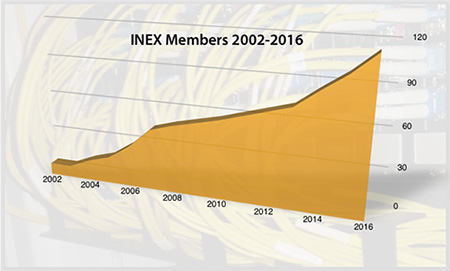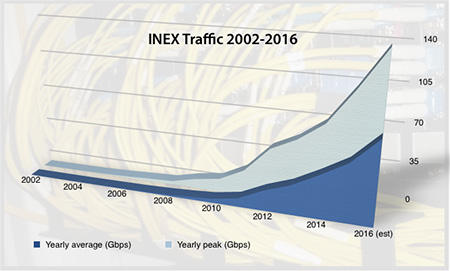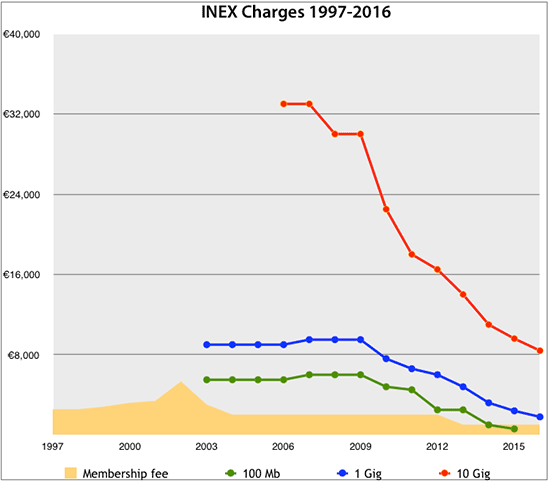INEX marked its twentieth birthday in September 2016 in a most appropriate way: by setting a new record for the volume of data flowing through its exchange points. Peering traffic exceeded 130 gigabits a second for the first time.
Some things never change. Two decades earlier the demand for online connectivity was also unprecedented. Internet data streams were swelling rapidly and Ireland’s service providers were projecting rampant growth for the foreseeable future. Those companies
were concerned about the high price of the international circuits that their services required. They also understood that they could control those costs if they were able to switch more of their customers’ traffic within Ireland.
In 1996 competing internet firms found a common cause and started to collaborate. A small group of service providers formally incorporated Internet Neutral Exchange Association Limited as a not-for-profit company in early September.

Four members of the new association began switching data in April 1997. By the turn of the century seven companies – all the major internet service providers – were connected to INEX. When the exchange celebrated its 20th anniversary, however, its membership had soared to more than 100. The story behind that growth trajectory reveals how the internet itself has evolved.
INEX, like its counterparts elsewhere, started as an internet service providers’ initiative. The project in its early years duly reflected their concerns. Gradually, though, the make-up of the association changed. Internet exchanges started to support peering by other organisations with technically stand-alone networks – ‘autonomous systems’ in the industry jargon. Mobile operators, hosting services and digital content distributors began to access the neutral connection points. Content providers were especially important for INEX, because so many international services had established data centres or points of presence in Ireland.
INEX shifted into a different gear in 2005, when it signed a loan agreement with IDA Ireland. Until then the exchange had been self-financing. Its participants paid a flat annual membership fee in the early years. Tiered charges, based on the capacity they needed, were introduced in 2003. The addition of external funding enabled the exchange to accelerate investment in its infrastructure. Collaboration with the agency that supported foreign investment in Ireland also encouraged more international companies to join INEX.

The addition of new members, including some very large organisations, drove up the volumes of data passing through the exchange. It took more than five years for the traffic level to climb above 100 Mbps for the first time. Four years later INEX recorded a 1 Gbps peak and, after another four years, the traffic increased to over 10 Gbps.
The files that made up all those gigabytes, moreover, were very different from the content that trickled through the exchange in its early years. When INEX experienced a record volume in 2002, it interpreted this as a new peak in email usage. Soon, however, the predominant file formats on the internet changed from text to multimedia and the key content types changed from workplace documents to non-business videos.
Traffic spikes at INEX no longer occurred during office hours. By 2009 the data levels in the evenings equalled daytime levels for the first time. More internet users were downloading or streaming files at home. Breaking records had become, and was to remain, a nighttime activity.
Another long-term trend at INEX has been the broadening of its geographic reach. The exchange started life as a local switching resource for companies in and around Dublin. Later on it drew in members from other parts of Ireland. In the 2010s it has also supported international organisations that want to distribute their connections in keeping with the decentralised ethos of the internet. These tactics sometimes involve peering at locations where they do not have a physical presence.
Supporting more members and bigger data flows have placed greater demands on the INEX technical infrastructure. At the end of its first 20 years the exchange runs six points of presence in Dublin and its newest switching centre, INEX Cork, is the first outside the city.
The progress of INEX is also reflected in the success of IXP Manager – the exchange management system that started as an internal project and was later adopted by other organisations. IXP Manager has become a thriving open source software project with implementations known to exist at more than 30 internet exchanges around the world.
The 2005 agreement between INEX and IDA Ireland envisaged that the exchange would complete its repayments in 2022. Thanks to its increased membership, as well as prudent management, INEX never needed to draw down all of the finance on offer and was able to reimburse the agency ten years earlier than expected. It paid back the loan in full before the end of 2012.

With no debts on its books, INEX has been able to apply regular reductions to the costs of peering. As the graph shows, the annual charge for
a port at the exchange fell steadily in the 2010s, following a plateau during the years of the loan. This chart focuses on the fee for a member’s first port in each of the main classes and does not display all the connectivity options available.
What these figures demonstrate clearly, however, is that collaboration works for everyone. The higher the number of members at the internet exchange, the lower the charges paid by all. Twenty years on, the basic cost-sharing principle behind the creation of INEX still holds true.
